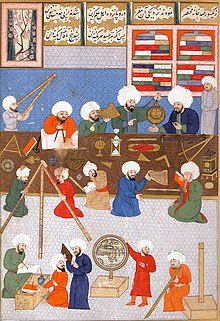|
Kızgın Tophaneliler padişahı da korkuttu
http://www.hurriyet.com.tr/yazarlar/15869323.asp

Education and research were on a high level in the Ottoman Empire after the conquest of Istanbul. Learning institutions were under the Sultan’s special protection. Not only Islamic theology but also useful sciences like astronomy, geology, mathematics and medicine were favoured by Mehmed II the Conqueror.
A 2010 Hürriyet column by Soner Yalçın describes a serious setback of science in Ottoman Empire and shows how trivial renditions of religion may attract the common man to the extent that whole nations may be sent centuries back in time. What we see happening today in many countries also took place in Istanbul during the reign of Sultan Murat III (1574-95), the grandson of Suleiman the Magnificient and Hürrem Sultan.
The tragic hero of the story is the astronomer Taqi al-Din Muhammad ibn Ma’ruf who founded one of the largest observatories in the world in Istanbul in 1577. The scholarship of Taqi al-Din was diverse:
Takiyeddin bin Muhammed bin El-Maruf Efendi (1521-1585) Şam ve Kahire medreselerinde eğitim aldı…İstanbul’a geldiğinde Osmanlı Sarayı’nın gözde âlimlerinden biri oldu. Nasıl olmasın: Dünyada ilk olarak hem de Avrupa’dan 10 yıl kadar önce ilk trigonometri tablolarını yaptı. 10’lu sistemle çarpma, bölme, karekök alma yollarını ortaya koydu. ‘Taqi al-Din Muhammad ibn Ma’ruf Efendi (1521-85) was educated in Damascus and Cairo schools. When he came to Istanbul he became one of the favourite learned men of the Palace. And why not: he was the first one in the world to make trigonometric tables, 10 years earlier than they were introduced in Europe. He presented ways to multiply, divide and take square roots within the decimal system.’
The Tophane Observatory was very much the work of Taqi al-Din:
Rasathanedeki kum saati, mekanik saati, gönye, gök küreleri, pergel ve cetvel gibi araçların hemen hepsini Takiyeddin Efendi kendi elleriyle yaptı. Rasathanenin elinde o zamana göre hayli gelişmiş gözlem aletleri vardı. Bu aletler yapılırken Avrupa’daki örneklerden faydalanıldığını tahmin edebiliriz. ‘Taqi al-Din made the observatory equipment such as sandglass, mechanical clock, set square, celestial spheres, compass and ruler by his own hand. The observatory had quite sophisticated means of that time for observation. Is has been presumed that while this device was prepared European examples were taken advantage of.’
Taqi al-Din’s observatory was destroyed according to the order of Sultan Murat III only five years later. The city had been afflicted by plague and earthquakes, a scary comet had been seen in the sky. People were scared. The religious adviser of the Sultan claimed the city had been cursed because of the observatory from where angels’ legs were peeked. Murat III had to give up to the demonstrators and have the observatory bombed. Needless to say, European science during the next centuries got a head start compared with the Ottomans.
And what happened to Taqi al-Din?
Rasathane yıkıldıktan kısa bir süre sonra kahrından öldü. ´He died of broken heart a short time after the observatory was destroyed.´
Edited (4/10/2012) by Abla
Edited (4/10/2012) by Abla
Edited (4/11/2012) by Abla
|

